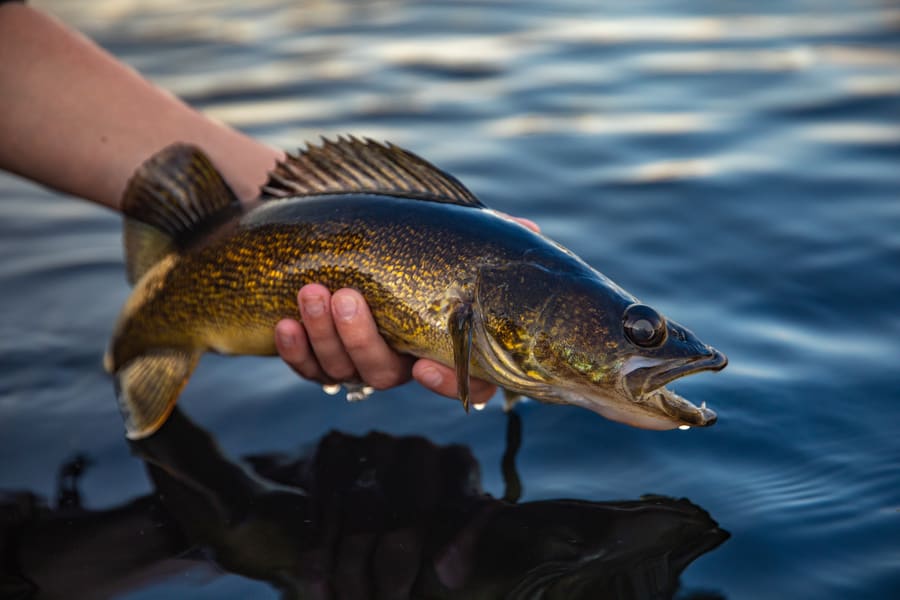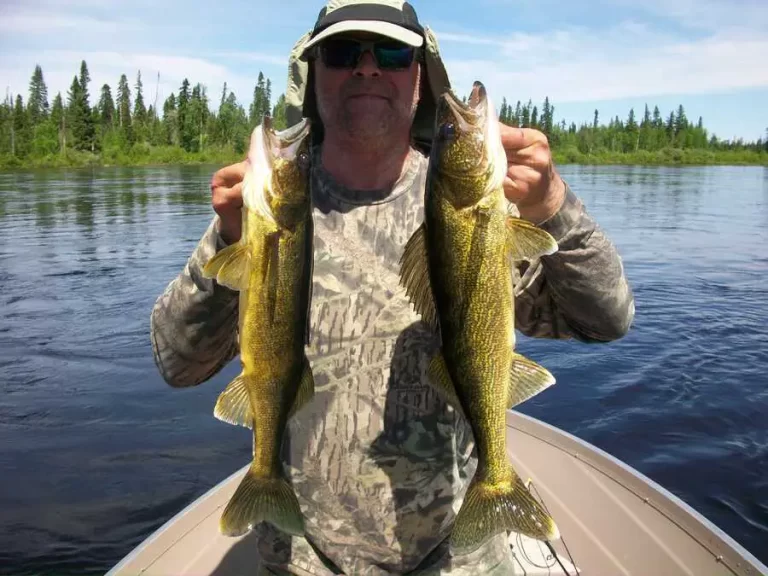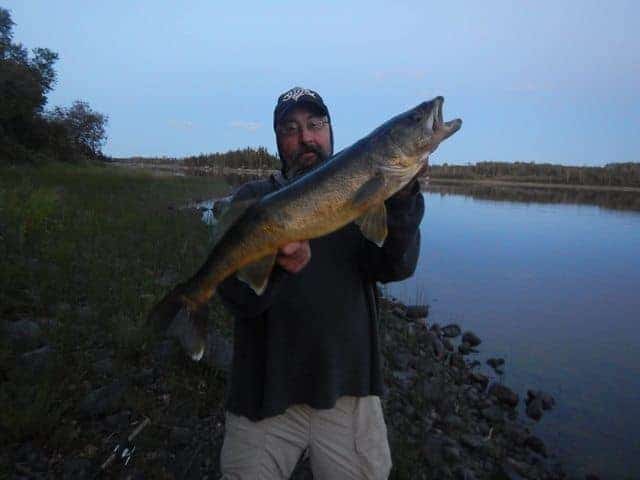How Water Clarity Impacts Walleye Fishing at Night
The nighttime is one of the best times to catch big walleyes as long as you can factor in water clarity.
At night, walleye actively search for food in clear water, yet they can be wary of unfamiliar objects. Walleye in murky waters are less focused on visuals, making them oftentimes easier to catch.

Table of Contents
Nightly Walleye Movement
Dusk Transition
As day turns to night, walleye make a big move. They leave the deep spots they hung out in during the day and head to the shallower areas. Why do they do this?
- Food Movement: The smaller fish that walleye eat start swimming in the shallower water. The walleye follow them into the shallows.
- Water Temperature: The sun heats the water during the day. When it sets, the top part of the water cools down a bit. Walleyes usually find this cooler water more comfortable.
- Dimming Light: Walleyes have special eyes that help them see well in low light. So, as it gets darker, they can hunt more efficiently.
Venturing the Depths
At night, walleyes don’t just stay in one spot. They explore:
- Surface Waters: The top layer of water often have schooling fish the walleye want to eat.
- Mid-depths: Here, walleyes find schools of baitfish such as shad and perch. It’s a good middle spot to fish.
- Deeper Zones: Sometimes, the walleyes dive deeper. Maybe they’re after bigger fish or just want to be in a colder place.
Underwater humps, rocks, and dips can help walleyes decide where to go. They use them as markers or rest spots.
Significance of River/Lake Features
Different parts of rivers and lakes can be like favorite hangout spots for walleyes:
- River Bends and Confluences: Where two rivers meet or where a river turns can be great for walleyes. The water here might be slower, and food can gather.
- Drop-offs: This is like a step underwater. Walleyes like it because they can easily change how deep they are. These are baitfish magnets too.
- Lake Features: Things like where water comes in or goes out can be full of food. Also, stuff under the water, like rocks or old trees, can be great ambush spots. One of my favorite places to find big walleye are deep rocks, especially during winter. This is a mecca for walleye and bass in cold water.
Click here to learn how weather impacts walleye fishing. Click here to learn how moon phase impacts walleye fishing.
The Nightly Ritual: Walleye Movement Patterns
Walleyes have a behavior pattern that comes alive as night sets in.
Dusk Transition
As evening’s soft glow weakens, a significant underwater migration occurs. Walleyes, known for their deep-water day habits, start inching closer to the water’s sunlit edges. But what’s the magnet behind this dance?
Schooling baitfish like perch, shad, and sawbellies, begin their twilight movement into shallow water closer to shore. The walleye have no choice but to follow.
Water’s warmer evening temperatures also draws in walleye. The shallows will be warmer with the retreating sun, drawing walleyes away from the day’s chillier depths.
Additionally, walleyes have specialized eyes. Their eye structure gives them excellent vision in low light. This advantage is especially useful at dusk, helping them hunt efficiently in shallow waters.
Probing the Watery Abyss
While the shallows attract the action, walleyes are not just confined there as night deepens. Some meander to the surface, others scout the mid-regions, and a few brave the deep unknown.
Underwater structures– rocky outcrops, fallen timber, walls, or even remnants of human activity like flooded roads – are particularly interesting to walleyes. These structures offer a blend of safety and an opportune hunting ground, making them invaluable landmarks to fish around.
Thermal gradients in the water, often called thermoclines, have a role to play. Walleyes, always seeking optimal conditions, are attracted to areas where these temperature shifts occur, finding a balance between warm and cool zones.
Decoding the Water’s Topography
The very blueprint of a water body can be a compass for walleye behavior. In the winding world of rivers, curves dig deeper watery pockets that walleyes find inviting. Meeting points of streams, or confluences, become hunting grounds due to the mixing waters churning up potential meals.
Then there are drop-offs which are underwater cliffs. These sites can act as highways for walleyes, allowing them swift transitions between depths or as strategic vantage points for hunting.
In the vast lake terrains, inlets and outlets emerge as zones of active foraging activity. Schools of shad and perch are chased by walleye and white bass. Additionally, any submerged relics shaped by nature or man become prime congregation sites for walleyes.
For a deeper dive into understanding walleye behavior, don’t miss our article on how water clarity directly influences daytime walleye fishing.
How Water Clarity Impacts Walleye Fishing at Night
Crystal Waters: Navigating the Transparent
In clear water, walleyes can see pretty well. Their eyes are built to work best in dim light, but they can spot their food from far away in bright and clear water.
For anglers, this can be tricky. Because the walleyes can see so well, they can also see your fishing line, boat, and shadow even in the dark. You have to be more careful and think of ways not to be seen.
Tip: Use thinner fishing lines or lines that match the color of the water. This can make it harder for walleyes to spot the line.
Muddy Mysteries: Adapting to Stained Conditions
When the water gets cloudy or muddy, walleyes can’t rely on their eyes as much. But they have a backup plan. They rely on their sense of feel to find food. If a small fish swims by, they can sense it.
For anglers, murky water can be both good and bad. The good part is that walleyes can’t see your line as easily. But, the challenging part is figuring out where the walleyes are since they might use structures or places to hide more often. You need to put your bait a lot closer to the face of the walleye to draw bites.
Tip: Use lures that make a bit of noise or vibration. This can get the attention of walleyes in stained waters.
Walleye in Turbid Waters
In really thick and dirty water, walleyes are mostly in the dark. They rely on their senses of feel and smell to find food. They move slower and are more careful.
For anglers, this is an interesting time. The walleyes are more careful but can’t see dangers (like your lure). If you find them, you have a good chance to catch them.
Tip: In super cloudy waters, try using scented baits. The smell can attract walleyes when they can’t see well.
Tailored Tactics: for Different Water Clarity Levels
Clear Water
In waters with high visibility, your bait must resemble actual fish. Walleyes have keen eyes in such conditions and will only go for realistic-looking baits.
Opt for hues that replicate local fish. Smaller sizes are generally effective, appearing as easy prey to walleyes. Soft baits can sometimes fool even the most cautious walleyes due to their lifelike feel upon bite.
With the water being so clear, walleyes will be skittish. Focus where deeper waters transition into shallower regions. On bright days, zones where sunlight reflects off the water can be prime spots, as they can attract baitfish.
Murkier Waters
In waters with reduced visibility, walleyes might not see as well, but they can detect movements through vibrations. Thus, lures that produce movement or sound can grab their attention.
Spinners can be effective, creating a noticeable vibration and light reflection. Vivid colors, including yellows, oranges, or shiny metallics, can make your lure more noticeable.
In these conditions, walleyes are near underwater structures like logs or rocks, waiting to ambush prey. Try casting beyond an obstacle and then reeling back. This can give the illusion of prey sneaking past, tempting the walleye.
Muddy Water
In extremely muddy waters, walleyes lean on their senses of smell and lateral line detection more. Lures that emit a strong odor or even live baits can be beneficial due to their natural movement and scent.
In darker waters, contrast is vital. Lures that glow or have prominent patterns can stand out. In such conditions, walleyes generally go to deeper regions, searching for more stable and clearer waters, and they frequent familiar territories.
Patience is the name of the game. The fish might take time to locate your bait, but bites will come if you’re positioned well.

10 Tips for Nighttime Walleye Fishing Based on Water Clarity
1. UV-Activated Lures in Clear Waters: Clear waters offer higher light penetration, especially under moonlight. Pick lures that have UV-reactive finishes. When exposed to UV light (either from moonlight or specialized UV flashlights), these lures can produce an irresistible shimmer, making them significantly more noticeable to walleyes.
2. Sound-Enhanced Rigs in Stained Waters: In moderately turbid waters, where visual appeal may be limited, walleyes rely more on their lateral line. Use lures with built-in rattles or attach snap-on sound beads to your line. The sound mimics crustaceans or distressed bait, enticing curious walleyes to investigate.
3. Scent Trails in Murky Waters: Walleyes leverage their acute sense of smell in the muddiest waters. Enhance your lure or bait with attractant gels or scented oils, creating a potent trail that tempts the walleye to follow the source. Fish attractant formulas designed explicitly for walleye can be a game-changer.
4. Surface Silhouette Strategy: In clear waters with bright moonlight, cast lures that create a defined silhouette against the surface, like topwater lures or suspending crankbaits. The distinct shadow might spark the interest of a walleye scanning the surface from below.
5. Vertical Jigging in Transition Zones: Focus on the transition zones for waters shifting from clear to stained or turbid. Walleyes often navigate these areas, adjusting to the change. Vertical jigging with spoons or blade baits can be effective, allowing you to cover various depths quickly.
6. Slip Bobbers for Precision: In stained waters, where walleyes are normally closer to specific structures (like a rock bed or submerged log), using a slip bobber setup allows you to maintain your bait at a precise depth, right where walleyes are likely to be patrolling.
7. LED Light Attraction: While not a traditional approach, submersible LED fishing lights can be effective in clear waters. They attract smaller baitfish, which, in turn, can lure in predatory walleyes. Ensure the light is a few feet from your main bait to prevent scaring off the walleye.
8. Oversized Soft Baits in Turbid Conditions: When dealing with very murky waters, increase the size of your soft baits. Larger swimbaits or worms create more movement in the water and emit stronger vibration patterns, making them more detectable to walleyes relying on their lateral lines.
9. Natural Bait in Stained-to-Clear Transitions: Natural bait (like live minnows or leeches) can be effective when fishing areas transition from stained to clear water. Their natural movements and scents provide authenticity, which can be harder for walleyes to resist, especially when navigating between two clarity zones.
10. Temperature Profiling in Mixed Clarity: Water clarity can affect temperature stratification. In regions with varied clarity, use a portable fishfinder or thermometer to identify temperature shifts at different depths. Walleyes might congregate in these transitional temperature zones, especially if a sweet spot offers comfort and prey.
FAQ: Addressing Common Queries
Does a full moon impact walleye behavior in clear waters?
A full moon casts a bright glow over clear waters, influencing walleye behavior. The extra light from the moon penetrates the water, allowing walleyes to see better. As a result, they can hunt more efficiently.
However, the increased visibility means that walleyes will be more cautious. It’s a double-edged sword: while they are more active, they may also be warier of lures and anglers.
What lure colors are best for walleyes in extremely murky conditions?
In very murky water conditions, the visibility is limited. Your choice of lure color can make a significant difference. Bright, reflective colors like silver and gold can be effective as they can catch any available light.
On the other hand, bold colors such as bright orange, chartreuse, and fluorescent pink can also be helpful as they provide a strong contrast in a cloudy environment.
How do water temperature and clarity levels interact during the night?
Water temperature and clarity do have an interconnected relationship during the nighttime. Colder waters tend to be clearer because there’s less algal bloom. During the night, as the temperature drops, the clarity can improve in many water bodies.
However, it’s essential to remember that other factors, like sediment disturbance or rain, can influence clarity regardless of temperature.
What’s the ideal depth to target walleyes based on different water clarities?
The ideal depth to target walleyes can vary based on water clarity. In crystal clear waters, walleyes might dive deeper during the day to avoid sunlight and come to the shallows at night.
In murky conditions, they stay relatively shallow, as the lack of clarity offers them some cover even during the daytime. It’s always a good idea to experiment with different depths until you find where the walleyes are most active based on the day’s specific conditions.





